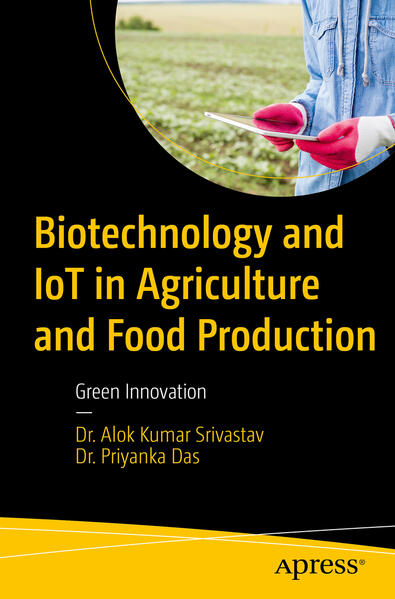
Zustellung: Do, 24.07. - Sa, 26.07.
Versand in 2 Tagen
VersandkostenfreiBestellen & in Filiale abholen:
Explore the transformative intersection of biotechnology and the Internet of Things (IoT) in modern agriculture. This book delves into sustainable solutions and cutting-edge technologies that are revolutionizing the global food production industry.
The book is structured to provide an in-depth understanding of how green innovation is reshaping agriculture. Starting with an introduction to sustainability in agriculture, it traces the evolution from traditional farming to smart farming methods, where IoT and Biotechnology come together to optimize crop management, soil health, and resource utilization. Key chapters include the role of IoT in precision farming, biotechnology advancements like CRISPR and GMOs, and their integration for improved crop resilience, pest control, and water management. The synergy between IoT's real-time data capabilities and biotechnology's genetic innovations is highlighted in smart greenhouses, vertical farming, and climate-resilient agriculture. Other critical topics include reducing food waste through technology, the role of AI and machine learning in agricultural practices, blockchain for supply chain transparency, and Biotech's impact on livestock management. Ethical considerations, regulatory frameworks, and green finance opportunities are also addressed, alongside future trends like 5G, drones, and synthetic biology.
You will gain a comprehensive view of how biotechnology and IoT are driving sustainable agricultural practices, fostering innovation, and offering solutions to global food security challenges. The book offers practical insights into the future of farming and policy recommendations to ensure a sustainable, tech-driven agricultural future.
You Will
Learn how data analytics, AI, and biotech innovations work together in precision farming, optimizing resource usage, improving yields, and addressing environmental challenges
Discover innovative solutions for sustainable food production, including smart irrigation systems, IoT-enabled greenhouses, vertical farming, and biotechnological methods for improving soil health and reducing food waste
Understand the ethical concerns, privacy issues, and regulatory frameworks that govern the use of IoT and biotechnology in agriculture
Who Is This Book For
Readers with a foundational understanding of agriculture, technology, or sustainability, though no specialized expertise is required. Beginners with an interest in how technology is reshaping food production can grasp the concepts, as the book breaks down complex topics into accessible language. A basic familiarity with IoT and biotech will enhance the learning experience but is not essential for following the book s key ideas.
Inhaltsverzeichnis
Chapter 1: Introduction to Green Innovation in Agriculture. - Chapter 2: The Evolution of Agriculture: From Traditional to Smart Farming. - Chapter 3: Understanding IoT in Agriculture. - Chapter 4: Biotechnology in Agriculture: A Primer. - Chapter 5: Synergies Between IoT and Biotechnology. - Chapter 6: Precision Farming: Merging Data and Biology. - Chapter 7: IoT-Enabled Greenhouses and Vertical Farming. - Chapter 8: Water Management and Irrigation Innovations. - Chapter 9: Pest Control and Disease Management: Smart Solutions. - Chapter 10: Sustainable Soil Health and Fertility. - Chapter 11: Climate-Smart Agriculture: Tackling Environmental Challenges. - Chapter 12: Reducing Food Waste Through IoT and Biotechnology. - Chapter 13: The Role of Artificial Intelligence in Agricultural Innovation. - Chapter 14: Blockchain and IoT for Transparency in the Food Supply Chain. - Chapter 15: Biotechnology and IoT for Sustainable Livestock Management. - Chapter 16: Ethical Considerations and Regulatory Challenges. - Chapter 17: Green Finance and Investment in IoT-Biotechnology Synergies. - Chapter 18: Challenges and Barriers to Adoption. - Chapter 19: IoT, Biotechnology, and the Future of Agriculture. - Chapter 20: Building a Sustainable Agricultural Future. - Chapter 21: Edge Computing and AI in Agricultural IoT. - Chapter 22: Agricultural Robotics and Autonomous Systems. - Chapter 23: Data Analytics and Machine Learning for Crop Management. - Chapter 24: Digital Twins in Agriculture. - Chapter 25: Future of Smart Agriculture: Integration and Innovation.
Produktdetails
Erscheinungsdatum
20. Juni 2025
Sprache
englisch
Auflage
First Edition
Seitenanzahl
316
Autor/Autorin
Dr. Alok Kumar Srivastav, Dr. Priyanka Das, Alok Kumar Srivastav, Priyanka Das
Verlag/Hersteller
Produktart
kartoniert
Abbildungen
XXIII, 291 p. 4 illus.
Gewicht
482 g
Größe (L/B/H)
235/155/18 mm
ISBN
9798868814686
Bewertungen
0 Bewertungen
Es wurden noch keine Bewertungen abgegeben. Schreiben Sie die erste Bewertung zu "Biotechnology and IoT in Agriculture and Food Production" und helfen Sie damit anderen bei der Kaufentscheidung.









